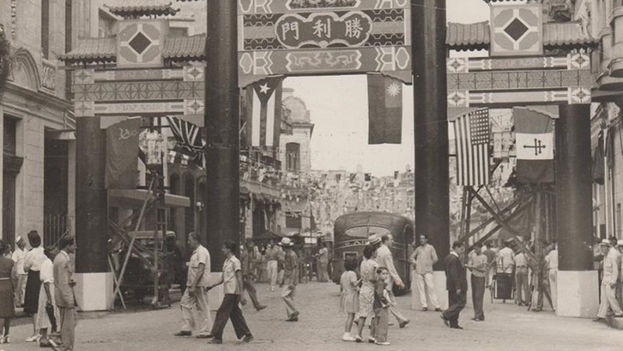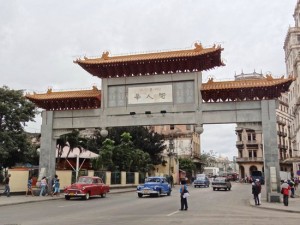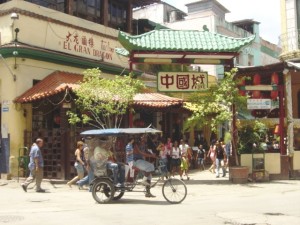THE CHINA QUARTER IN HAVANA, CUBA.
A modest eatery, which sits on the corner of Zanja and Rayo, and one destined to the sale of fruits and fried gave rise in 1858 to Chinatown in Havana. He grew up the neighborhood with astonishing speed and a hundred years after our “yellow city”, as he called the writer Alejo Carpentier, was the oldest Chinese community in Latin America. You have ups and downs throughout its history. Today, when Chinese origin were replaced largely by his Creole descent, also slanting eyes, this piece of the Cuban capital continues to show its exotic appeal. Walk the streets, sniffing at its corners, visiting souvenir shops, is a splendid cultural proposal is complemented by a wide range of restaurants where exquisite traditional Chinese culinary art opens space to the Cuban and international table. There are to choose from.
LONG JOURNEY WITHOUT RETURN.
The first Chinese arrived in Cuba on June 3, 1847 aboard the frigate Oquendo. Called “coolies” were hired to work in the sugar cane plantations, and everyone thought return to China loaded with glory and money, but waiting slavery governed by a contract that forced misleading to work for eight years with a pay four pesos. In this way, and until 1874, they arrived in Cuba 124 873 Chinese, but the figure should have been higher, since there was also a clandestine trade.
Only in 1877 a treaty between China and Spain banned the trading system. But since 1855, the first “coolies” broke free of their contracts after a period of eight years specified; none had means to return to China. The same happened to those released gradually thereafter. For all, it already became free workers were very few sources of jobs: construction, trade and agriculture, which would be devoted to small near Havana then orchards. They reside sought by the Real Ditch and around the market supply of the city, which sell their products.
From 1860 until 1875, I -parallel up the “coolies” – another blow to Chinese immigrants. Number about five thousand and come from California, USA, freely, voluntarily, attracted by the facilities for capital investment. Californians are called Chinese. Mostly, they shall file their shops in the vicinity of Zanja and Rayo, which is already settled other traders.
There, in 1874, the first great Chinese restaurant that was in Cuba, with invented in San Francisco, California Chinese dishes, and adapted to Western tastes is established and, of course, the Cuban palate. Because they were not just the usual Chinese customers such houses Cuban food, but worked in the warehouses of snuff in the area.
After the arrival of Californians occurred in poor and wealthy Chinese Chinese Cuba. These, those old “coolies” were dedicated to agriculture and small business. The other, established large houses importing Asian products, invested in the sugar industry -llegaron to buy mills in the Midwest and in Matanzas and introduced the Chinese Theatre, the charade as gambling and prostitution, with girls brought from China and US They also introduced the drug. Beautiful girls were coming home to marry or they did with wealthy Cubanitas. The poor Chinese who arrived alone, or were married couples with Cuban, mostly black and mulatto.
A PORCH, a large portico.
Soon they regents and for Chinese shops spread throughout Havana and reached the rest of the island. Famous were the cellars, carwashes and inns, which met the expectations of low-income sectors, like fruit stands with its chips, among others, those rolls of charitable bean ice cream and cod with bread, dried cod, with bones and skin, coming in Norway in wooden boxes. Chinese soup Single Market deserves a special mention.
Chinese Cubans are determined to maintain their traditions. The language is taught. There is a call Chinese cemetery in Nuevo Vedado. The first Sunday of April is, for them, the day of the faithful departed. That day, according to the Buddhist rite, carrying incense and flowers to the graves of their loved ones and food, especially chicken or pork, roast invariably. Do not leave food there. When they decide to leave, they gather amid nods, and lead society to which they belong, where consume. Chung Wah Casino is making efforts to rescue and preserve traditional Chinese culture as it relates to dance, music and cuisine. It is interesting to note that in traditional Chinese festivals do not dance. They have more of a family nature or friendly meeting, preparing for, yes, dishes, still in its development conjugation Taoist yin and yang, that is, the two principles or breaths that conflict or harmony gave birth to the universe and man.
At the corner of Dragons and Friendship, a porch of 19 meters wide, beautifully decorated, and whose architecture responds to the styles of the Ming and Ching, marks one of the entrances to Chinatown in Havana dynasties. A memorable and enriching experience. Attractive exotic.
CiroBianchiRoss / InternetPhotos / www.theCubanhistory.com
The Cuban History, Hollywood.
Arnoldo Varona, Editor.
CUBA PHOTOS. Calle del Vedado, Habana.

EL BARRIO CHINO EN LA HABANA, CUBA.
Una modesta casa de comidas, asentada en la esquina de Zanja y Rayo, y un puesto destinado al expendio de frutas y frituras dieron origen, en 1858, al Barrio Chino de La Habana. Creció la barriada con celeridad asombrosa y cien años después nuestra “ciudad amarilla”, como la llamó el escritor Alejo Carpentier, era la mayor colonia china de Latinoamérica. Altas y bajas tendría a lo largo de su historia. Hoy, cuando los chinos originarios fueron sustituidos en buena medida por su descendencia criolla, también de ojos oblicuos, este pedazo de la capital cubana sigue mostrando su exótico atractivo. Recorrer sus calles, husmear en sus rincones, visitar sus tiendas de souvenir, es una espléndida propuesta cultural que se complementa con una amplia oferta gastronómica donde el exquisito y tradicional arte culinario chino abre espacio a la mesa cubana e internacional. Hay dónde escoger.
VIAJE LARGO Y SIN REGRESO.
Los primeros chinos llegaron a Cuba el 3 de junio de 1847 a bordo de la fragata Oquendo. Los llamados ”culíes” habían sido contratados para trabajar en las plantaciones de caña de azúcar, y todos pensaban regresar a China cargados de gloria y dinero, pero los esperaba la esclavitud regida por un contrato engañoso que los obligaba a laborar durante ocho años con un jornal de cuatro pesos mensuales. Por esa vía, y hasta 1874, arribaron a Cuba 124 873 chinos, pero la cifra debe haber sido superior, pues hubo también una trata clandestina.
Solo en 1877 un tratado entre China y España prohibió el sistema de contratación. Pero desde 1855, los primeros “culíes” lograron liberarse de sus contratos, una vez transcurridos los ocho años estipulados; ninguno tuvo medios para regresar a China. Lo mismo sucedió a los que se liberaron paulatinamente a partir de esa fecha. Para todos, convertidos ya en trabajadores libres, había muy pocas fuentes de empleo: la construcción, el comercio y la agricultura, a la que se dedicarían en pequeños huertos cercanos a La Habana de entonces. Buscaban residir junto a la Zanja Real y en los alrededores del mercado de abasto de la ciudad, donde venderían sus productos.
A partir de 1860 y hasta 1875, arriba —paralelo a los ”culíes”— otro golpe de emigrados chinos. Suman unos cinco mil y vienen desde California, EE.UU., libremente, por voluntad propia, atraídos por las facilidades para la inversión de capitales. Son los llamados chinos californianos. En su mayoría, radicarán sus comercios en las inmediaciones de Zanja y Rayo, donde se asentaban ya otros comerciantes.
Allí, en 1874, se estableció el primer gran restaurante chino que hubo en Cuba, con platos chinos inventados en San Francisco, California, y que se adaptaban al gusto occidental y, por supuesto, al paladar cubano. Porque no eran chinos precisamente los clientes habituales de esas casas de comida, sino cubanos que trabajaban en los almacenes de tabaco de la zona.
Tras la llegada de los californianos hubo en Cuba chinos ricos y chinos pobres. Estos, aquellos antiguos “culíes”, seguían dedicándose a la agricultura y al pequeño comercio. Los otros, establecieron grandes casas importadoras de productos asiáticos, invirtieron en la industria azucarera —llegaron a comprar ingenios en la región central y en Matanzas— e introdujeron el teatro chino, la charada como juego de azar y la prostitución, con muchachas traídas de China y EE.UU. También introdujeron la droga. Hacían venir bellas muchachas de su país para contraer matrimonio o lo hacían con cubanitas adineradas. Los chinos pobres, que llegaban solos, casaban o formaban parejas con cubanas, sobre todo negras y mulatas.
UN PÓRTICO, UN GRAN PÓRTICO.
Pronto los comercios regenteados por chinos se extendieron por toda La Habana y alcanzaron el resto de la Isla. Célebres fueron las bodegas, los trenes de lavado y las fondas, que satisfacían las expectativas de sectores de pocos recursos, al igual que los puestos de frutas con sus frituras —entre otras, aquellos bollitos de frijol carita— helados y el bacalao con pan, un bacalao seco, con espinas y pellejo, que venía en Noruega en cajas de madera. La sopa china del Mercado Único merece una mención aparte.
Se empeñan los chinos cubanos en mantener sus tradiciones. Se enseña el idioma. Hay un llamado cementerio chino en el Nuevo Vedado. El primer domingo de abril es, para ellos, el día de los fieles difuntos. Ese día, según el rito budista, llevan incienso y flores a la tumba de sus seres queridos y también comida, sobre todo pollo o cerdo, invariablemente asado. No dejan allí los alimentos. Cuando deciden marcharse, los recogen en medio de inclinaciones de cabeza, y los llevan a la sociedad a la que pertenecen, donde los consumen. El casino Chung Wah realiza esfuerzos por rescatar y preservar la cultura tradicional china en lo que se refiere a la danza, la música y la culinaria. Es interesante anotar que en las fiestas tradicionales chinas no se baila. Tienen más bien un carácter de reunión familiar o amistosa, para las que preparan, eso sí, platos típicos, que siguen en su elaboración la conjugación del yang y el yin taoístas, esto es, los dos principios o alientos que por conflicto o armonía dieron origen al universo y al hombre.
En la esquina de Dragones y Amistad, un pórtico de 19 metros de ancho, bellamente decorado, y cuya arquitectura responde a los estilos de las dinastías Ming y Ching, marca una de las entradas al Barrio Chino de La Habana. Una visita memorable y enriquecedora. De exótico atractivo .
CiroBianchiRoss/InternetPhotos/www.theCubanhistory.com
The Cuban History, Hollywood.
Arnoldo Varona, Editor.



 THE CHINA Quarter in Habana, Cuba. *** El Barrio Chino en la Habana, Cuba.
THE CHINA Quarter in Habana, Cuba. *** El Barrio Chino en la Habana, Cuba.




